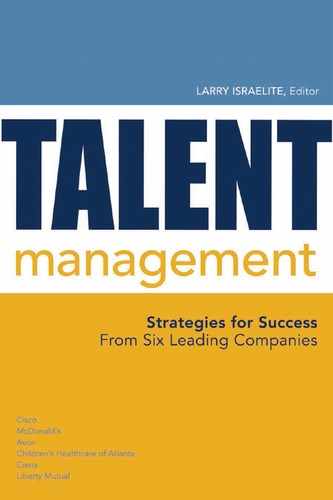Preface and Acknowledgments
It was with some trepidation that I invited people to contribute to this book, because the track record of companies that have been held out as exemplars of best management practices is not what one might like it to be. The challenge, of course, is that times change—as do the economy, technology, natural resources, and the public’s taste. What was popular one year may be less so the next. What once worked may not work as well now. And finally, what the employees of one generation may have wanted from their employers is, arguably, different from what those who follow them want. So, I suppose, it is not all that surprising that the results of a search for excellence or an analysis of what it takes to move from good to great might differ from decade to decade, if not year to year.
Yet the good news is that I am making no claims whatsoever that what is presented here represents “best practices in talent management.” That would be presumptuous at best and, based on the history of this sort of thing, potentially dangerous. Rather, the authors who have generously contributed chapters to this book describe those talent management practices that have worked for them in their organizations. No one is claiming that what worked for them will work for you—though all who have contributed, I expect, believe that their firm’s talent management practices do contain some universal truths about how to manage talent so that its value is maximized. But all such things are local. The talent management practices described here comprise a combination of philosophies, tools, processes, and systems that have resulted in tangible benefits for those who have used them—more capable managers, a deeper bench, increased employee engagement, and, one hopes, better business results. So we know that, at some level, they work. The trick is to figure out how and why.
Given this book’s subject, one could reasonably expect that each chapter would be roughly the same, with the major difference being the business context in which the talent is being managed. After all, how much different could talent management practices be from company to company? The answer to this question, as you will see, is that these practices do have some common names, but how they are used from organization to organization can differ quite a bit.
These differences among how the six companies that are profiled in this book manage their talent is what I hope will make the book interesting for you. Some of the companies are large, and some are smaller; most are in business to make a profit (and proud of it), but one is not. From an industry perspective, they cover high technology, food services, health care, consumer products, and financial services. Some have specific internal organizations that focus on talent management, and others do not. Today, all these companies are considered successful, though, as we know all too well, success can be fleeting. But in its own way, each firm has decided that a comprehensive approach to managing talent is a worthwhile endeavor. And in all cases, they would claim that some portion of their success can be attributed to the investments they have made in it.
In addition to giving the stories of practitioners, I have attempted to provide some context for the talent management story. In chapters written by an analyst, an experienced observer, and the CEO of a software company, you will find the opportunity to look at talent management challenges from a variety of perspectives. This is not to say that one is better than the other—just perhaps a little different.
So have a look, be open to new ideas, think about some things you haven’t thought about before, find some tool or technique that might be helpful to you, or just enjoy your reading. I hope you will find something useful in these pages and that something you read here might enable you to make your way through the maze of talent management with a little less resistance and fewer wrong turns. If this book helps you to do that,then we will have created something of value—and that, in the end, is all we could hope for.
Finally, I had a very interesting experience as I was doing my job as editor of this volume. As I read through the first drafts of each chapter, I forgot my role. I ceased being the editor and instead became an eager reader, trying to figure out how I could take the talent management practices each author describes and apply them to my work at the Liberty Mutual Group. I learned a great deal during the editing process, and I can say with absolute certainty that I plan to steal shamelessly from what I have read. I hope you have the same experience.
As much as we editors want to believe that we are the stars of the show, deep in our hearts, we know the truth. So I would be remiss if I did not recognize and thank the people who made this project possible:
- The nine talent management professionals who gave generously of their knowledge, expertise, experience, and time as their chapters moved through the various stages of development and production. I am truly grateful to them for their contributions and greatly admire the work they do each and every day.
- Everyone at the Liberty Mutual Group who chose to make the management of talent such an important part of the company’s business strategy and who gave me an entirely new perspective on what it means to manage talent well.
- ASTD, for giving me the opportunity to embark on this journey.
- And, of course, to Wendy and the boys, who know how I feel and, I hope, understand how much of what I am I owe to them.
Larry Israelite
November 2009
